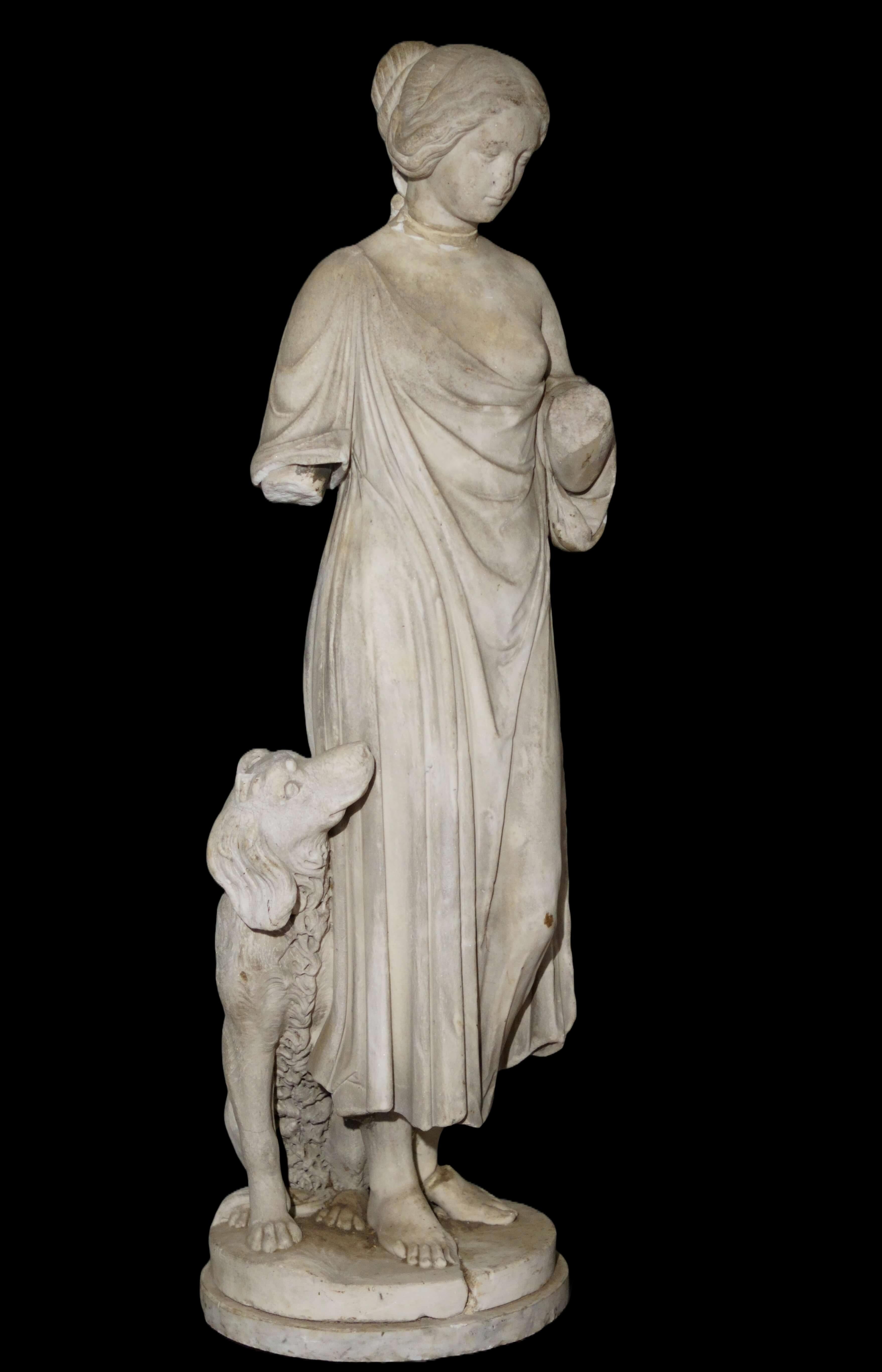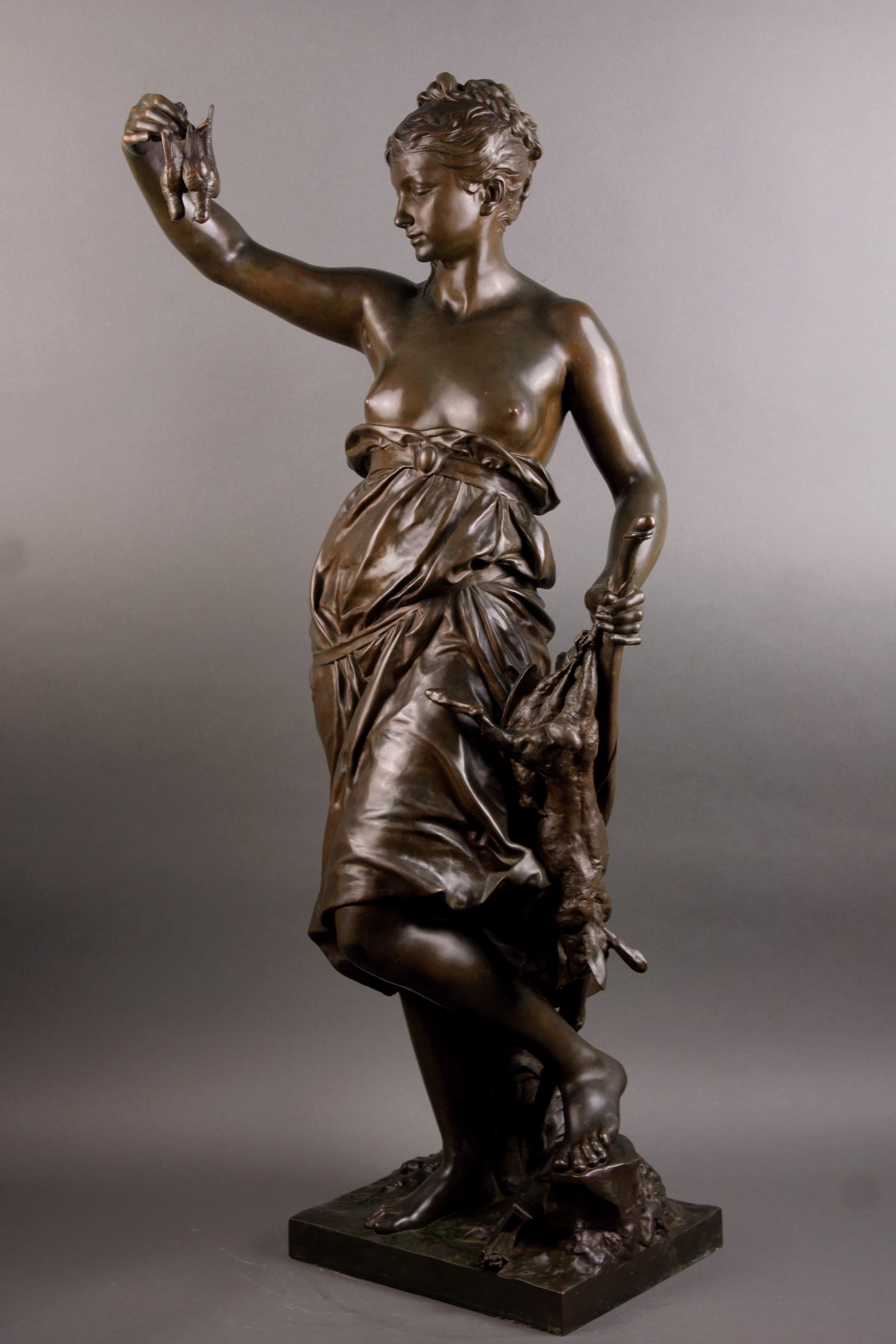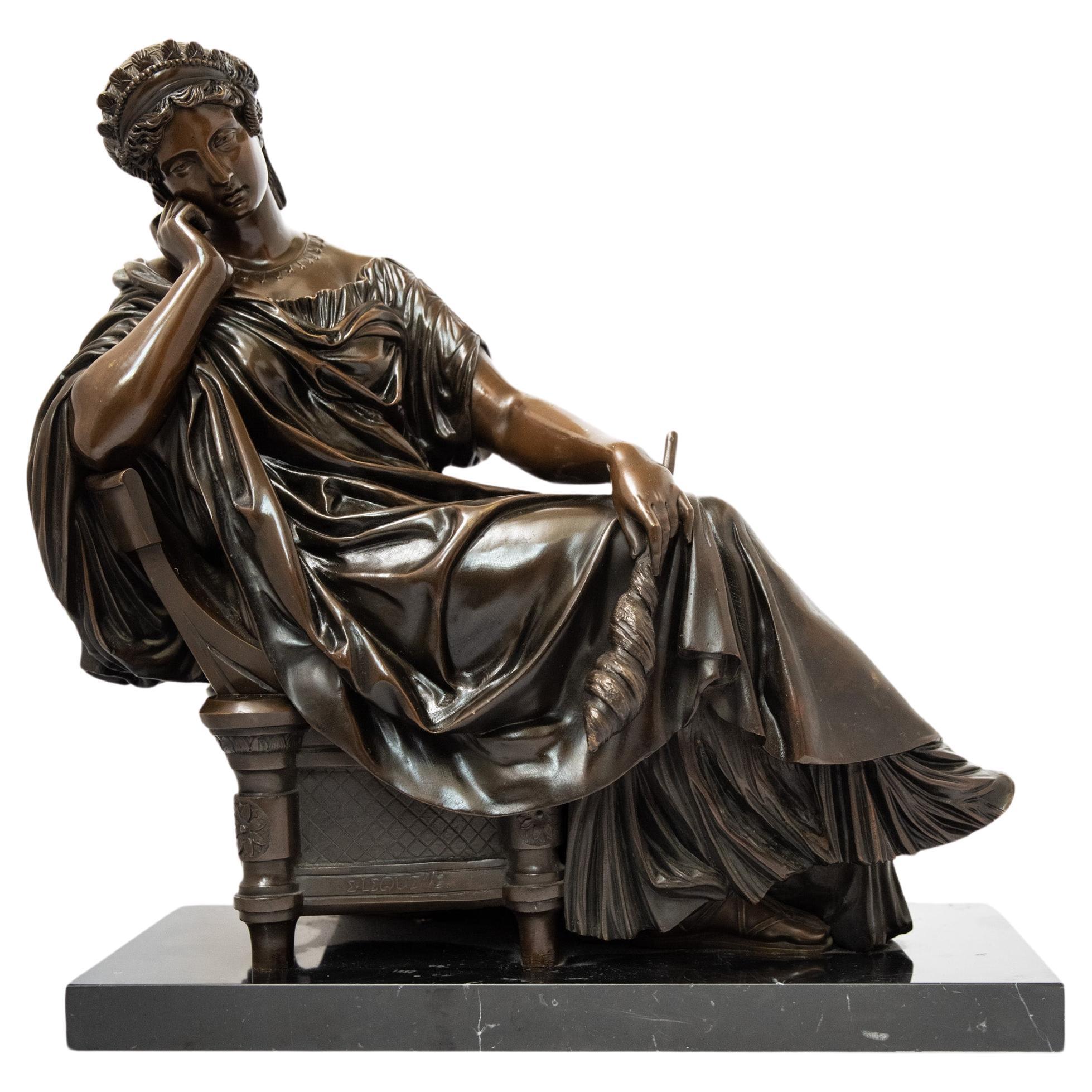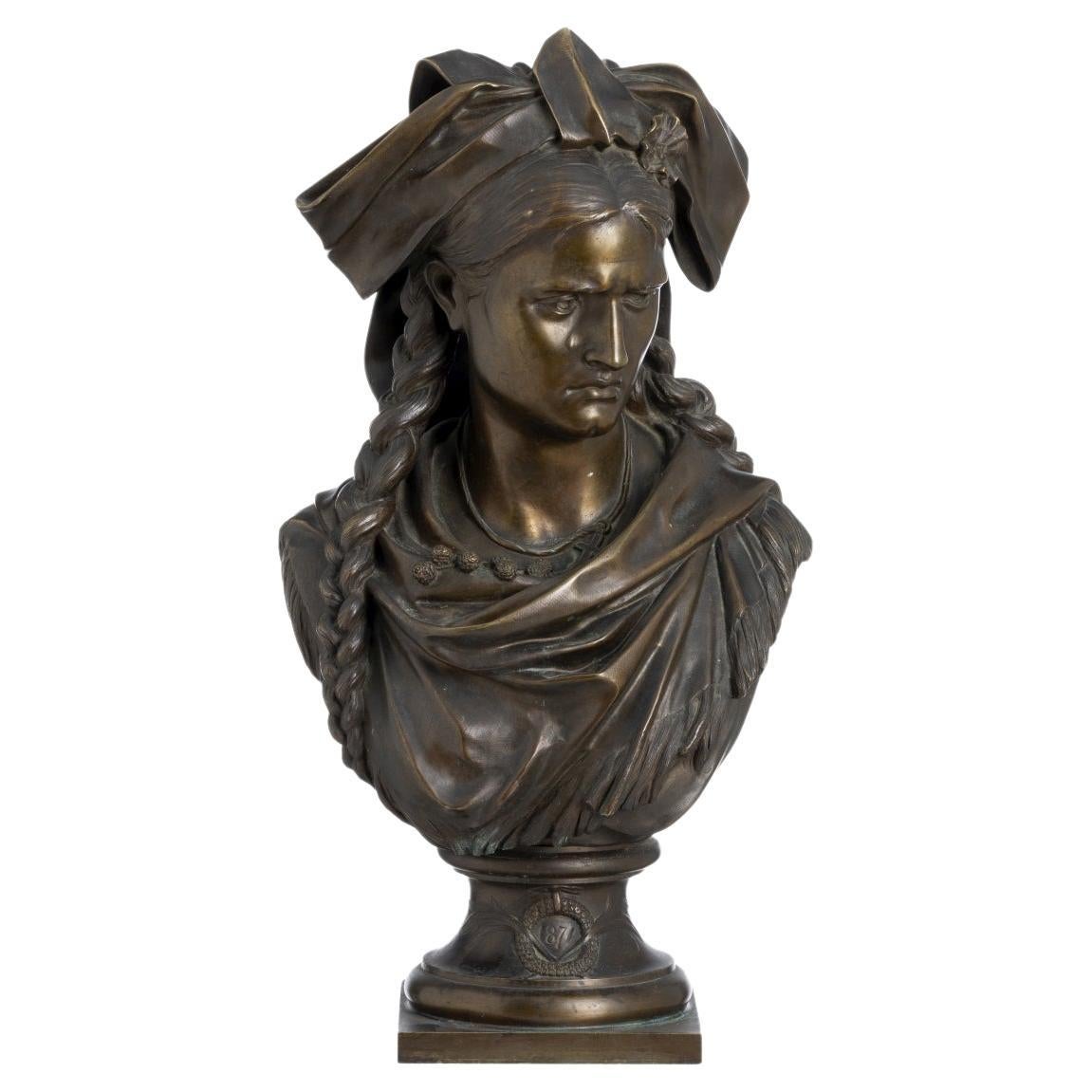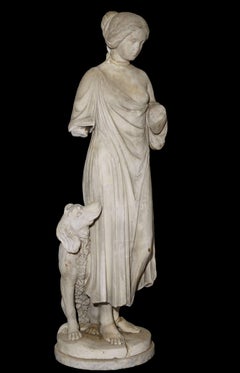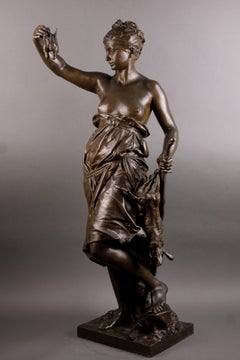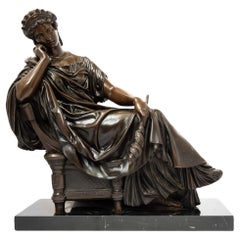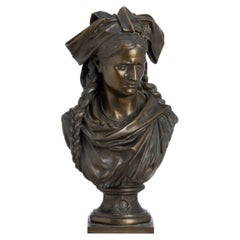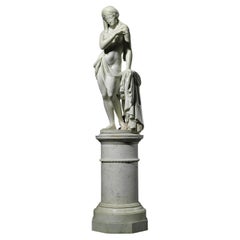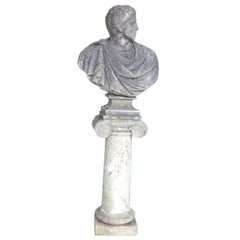Items Similar to Imposing French Cast Iron Statue 19th century Foundry of Tusey "Polyhymnia"
Want more images or videos?
Request additional images or videos from the seller
1 of 13
Fonderia di TuseyImposing French Cast Iron Statue 19th century Foundry of Tusey "Polyhymnia"1896
1896
$6,165.32
£4,590.89
€5,200
CA$8,471.49
A$9,481.19
CHF 4,948.45
MX$115,621.63
NOK 63,333.45
SEK 59,953.22
DKK 39,583.05
Shipping
Retrieving quote...The 1stDibs Promise:
Authenticity Guarantee,
Money-Back Guarantee,
24-Hour Cancellation
About the Item
Impressive cast iron sculpture titled "Polymnie," Tusey Foundry, late 19th century.
Fine Arts export certificate available.
In modern times Tusey, a village in the Meuse, was best known for its renowned foundry. The foundry later took the names Muel, Muel et Wahl, Zégut Gasne, Dufilhol et Chapal, Dufilhol, Chevaillier... It is one of the most important companies specializing in artistic casting.
Established in 1832 by Pierre Adolphe Muel, a member of a family of Vosges ironworking masters, the Tusey foundries were oriented from the beginning toward the manufacture of cast iron artistic objects. Muel will create the two fountains and sixteen rostral columns at Place de la Concorde (1837-1838). This cast-iron street furniture, a symbol of the union of Art and Industry, created by Jacques Hittorff is the first and masterful example of a production that would revolutionize urban planning and export a French art of living around the world. In his treatise: On Foundry as it exists in France..., André Guettier, a professor at the Royal School of Arts and Crafts in Angers, and former director of the Tusey foundry (1839-1843), describes precisely the techniques for making and lining the Place de la Concorde fountains. It thus testifies to perfectly mastered know-how from the first half of the 19th century.
Muel joined forces with Wahl in 1840. Later the factory was taken over by Ed Zegut (1862-1874), a former associate of the founder of the Haute Marne art, Antoine Durenne. Louis Gasne succeeded him in 1874. During the 1889 World's Fair in Paris, there were plans to present a monumental fountain under the Eiffel Tower, but this creation was not ready in time, which explains why the fountain was made of plaster and was never done. He took over the Thiébaut foundry in 1896.
In 1861, Jean Baptiste Barbe and his son Paul Barbe became the owners of the Forges de Tusey.
Zégut then Gasne entered into a contract with Louis Thiriot, a model owner in Paris (92, rue Amelot). Some Thiriot models appear in the Zégut catalog. Gasne's (1890) includes all the models in the Thiriot catalog (1887). These models will be purchased by Capitain-Gény and Salin (master forgers and brothers-in-law) at an undetermined date. A number of them now appear in the funds of these companies that became Ferry-Captain and Ateliers Salin.
In 1896, the factory passed into the hands of Paul Dufilhol (1860-1937) and Gaston Chapal (1871-1921). Gaston Chapal's stay in Tusey was short-lived; in 1898 he took over, with his father, the Kerloc foundries and workshops in Auray. At the same time, he managed the sawmills and workshops in Voutenay (Yonne). Paul Dufilhol, owner from 1897 to 1904, continued the foundry business alone until his bankruptcy in 1904. He enriched the collection with artistic models.
In 1906, the factory was bought by Laurent Chevailler, who produced war memorials and ceased production of artistic characters around 1920. Laurent Chevailler's heirs succeeded him (there is a 1925 catalog that no longer includes artistic characters, but simply blacksmithing elements): balconies, window sills, etc.). This company was taken over by Pierre Esch in 1935. It merged with Ateliers et Fonderies de Meuse (formerly Fonderie Jeanne d'Arc in Vaucouleurs), which became Fonderies de Vaucouleurs in 1961. The Tusey site was abandoned in 1963, and production of the mechanical cast iron was redirected to Vaucouleurs. Present at the Universal Expositions from 1851 to 1900 and the National Expositions, this foundry regularly won awards and medals.
Polymnie, an imposing cast iron sculpture measuring 112 cm in height, is published in the Fonderie de Tusey catalog for the years 1895 and 1896, during Dufilhol's direction, on page 76. The foundry had made, uniquely, the statue of the nine Muses and their guide, Apollo.
Traces of Tusey's F.ie signature are still visible at the base of the sculpture. Traces of gilding at crown and hammer.
Upon request I can provide photos from the catalog, which accompany the sculpture. Original patina. Excellent state of conservation.
- Creator:Fonderia di Tusey (1832 - 1904, French)
- Creation Year:1896
- Dimensions:Height: 44.1 in (112 cm)Width: 13.39 in (34 cm)Depth: 11.82 in (30 cm)
- Medium:
- Movement & Style:
- Period:
- Condition:
- Gallery Location:Pistoia, IT
- Reference Number:1stDibs: LU2746215883192
About the Seller
4.5
Gold Seller
Premium sellers maintaining a 4.3+ rating and 24-hour response times
Established in 1997
1stDibs seller since 2024
14 sales on 1stDibs
- ShippingRetrieving quote...Shipping from: PISTOIA, Italy
- Return Policy
Authenticity Guarantee
In the unlikely event there’s an issue with an item’s authenticity, contact us within 1 year for a full refund. DetailsMoney-Back Guarantee
If your item is not as described, is damaged in transit, or does not arrive, contact us within 7 days for a full refund. Details24-Hour Cancellation
You have a 24-hour grace period in which to reconsider your purchase, with no questions asked.Vetted Professional Sellers
Our world-class sellers must adhere to strict standards for service and quality, maintaining the integrity of our listings.Price-Match Guarantee
If you find that a seller listed the same item for a lower price elsewhere, we’ll match it.Trusted Global Delivery
Our best-in-class carrier network provides specialized shipping options worldwide, including custom delivery.More From This Seller
View AllGrande Scultura Italiana in Marmo Neoclassica Allegoria XVIII secolo
Located in Pistoia, IT
Imponente scultura neoclassica in marmo di Carrara raffigurante l'Allegoria dell'Amicizia e della Fedeltà, seconda metà del XVIII secolo.
La scultura rappresenta l'Amicizia come un...
Category
Late 18th Century Italian School Figurative Sculptures
Materials
Marble
19th Century French Sculpture Bronze Patinated and Gilded Barbedienne Fondeur
By Jean-Baptiste Clésinger
Located in Pistoia, IT
"Helen of Troy," large bronze sculpture with brown patina signed at base J.Clesinger-Rome 1864-F. Barbedienne foundryman and bearing Collas mechanical reduction seal.
Auguste Clésin...
Category
1860s French School Figurative Sculptures
Materials
Bronze
The Hunt Large Bronze Sculpture Ferdinand Barbedienne Fondeur Napoleon III
By Louis Ernest Barrias
Located in Pistoia, IT
Louis-Ernest Barrias (1841-1905) "The Hunt.
Impressive bronze sculpture with brown patina, 98 cm tall. Signature "E. Barrias" on the rock; "F. Barbedienne fondeur Paris" and mechanic...
Category
Late 19th Century French School Figurative Sculptures
Materials
Bronze
Large Neoclassical White Marble Sculpture Venus Italica mid-19th century
Located in Pistoia, IT
Venus Italica, imposing sculpture in white Carrara marble, mid-nineteenth-century Roman atelier.
Antonio Canova made several sculptures depicting Venus. The first was made as compen...
Category
Mid-19th Century Italian School Figurative Sculptures
Materials
Marble
Grande Scultura in Alabastro Satiro con Cimbali Bottega Volterrana XIX secolo
Located in Pistoia, IT
Grande scultura in alabastro raffigurante il Satiro con i cimbali, bottega volterrana del 19 secolo.
Il satiro con cimbali è una scultura romana in marmo conservata al museo degl...
Category
1870s Italian School Figurative Sculptures
Materials
Alabaster
Grande Busto Orientalista in Marmo di Armida Scuola Francese XIX secolo Firmato
Located in Pistoia, IT
Zacharie Rimbez (attivo tra 19 e 20 secolo). Busto orientalista in marmo bianco raffigurante Armida, seconda metà del 19 secolo.
Armida è una maga musulmana, personaggio della Ge...
Category
Late 19th Century French School Figurative Sculptures
Materials
Marble
You May Also Like
Early 19th Century Bronze Sculpture by Lequesne
By (after) Eugène-Louis Lequesne
Located in 263-0031, JP
A pensive figure, evocative to the many depictions of Sappho produced during the Romantic Era, of a seated woman by the French sculptor Eugène Louis Lequesne (1815-1887). She and her...
Category
Antique 19th Century French Figurative Sculptures
Materials
Marble, Bronze
$1,824 Sale Price
20% Off
Jean-Louis Grégoire (1840-1890)
Located in Porto, PT
"Alsace 1871". Bronze sculpture. Signed and dated 1879. Dim. Height: 48 cm.
Category
Antique 19th Century French Figurative Sculptures
Materials
Bronze
Sculpture Scipione Tadolini the Greek Slave Second Half of the 19th Century
By Scipione Tadolini
Located in SAINT-JEAN-CAP-FERRAT, FR
Scipione Tadolini was a skilled sculptor whose broad talent covered the neoclassic to the romantic movements. His ancestors from a dynasty of Roman sculptors exerted a profound and lasting influence on the artistic production of the Eternal City. The Greek Slave fully demonstrates his masterly talent and serves as a reminder of antique models and the orientalist influences characterising the second half of the 19th century.
Scipione Tadolini graduated from the Roman Academy and worked with his father on a series of celebrated portraits and ecclesiastical sculptures for Roman churches including a bust of Cardinal Giuseppe Alberghini for the Gesù (1847) and portraits of various members of the Cini family for the Church of Sant’Andrea della Valle (1844, 1846). Tadolini is also known as the author of a number of large-scale monuments for patrons around the world including an equestrian group of Simon Bolivar for the city of Lima, Peru. One of his best known sculptures is The Greek Slave which appears in his work from the late 1850s forward.The Greek Slave was created in several sizes in two variations: with the figure’s hand either raised to her chest or to her chin. The small number of versions all indicate the sculptor’s careful attention to the human form and passion with exoticism, which can be noticed through the tumbling folds of the present figure's headdress and the finely articulated jewellery...
Category
Antique Mid-19th Century Italian Neoclassical Figurative Sculptures
Materials
Marble
Roman Dignitary Sculpture
Located in Marseille, FR
Soft stone sculpture representing a Roman dignitary from the 1900s on a stand with a column with a capital, 212 cm high for a tray size of 76 cm by 40 cm. Comes from the garden of a ...
Category
Antique 19th Century Figurative Sculptures
Materials
Stone
$10,552
Émile Louis Picault Bronze Sculpture
By Émile Louis Picault
Located in Astoria, NY
Emile Louis Picault (French, 1833-1915) "Paris" Patinated Bronze Sculpture, late 19th century, the standing figure holding a golden apple, signed to base. 32" H x 12" W x 12" D. The ...
Category
Late 19th Century Art Nouveau Figurative Sculptures
Materials
Bronze
Goddess Circe Italian Neoclassical Sculpture Early 1800s Carved Ebonized Re-gilded
Located in Milano, MI
Circe Italian Neoclassical Sculpture of Early 1800s the figure is a fascinating depiction of the Goddess Circe, made in Italy in the early 19th century. The pine wood carving and ebo...
Category
Antique Early 19th Century Italian Neoclassical Figurative Sculptures
Materials
Hardwood, Pine
